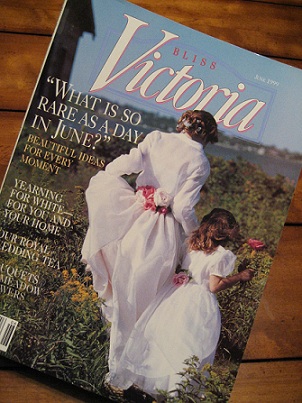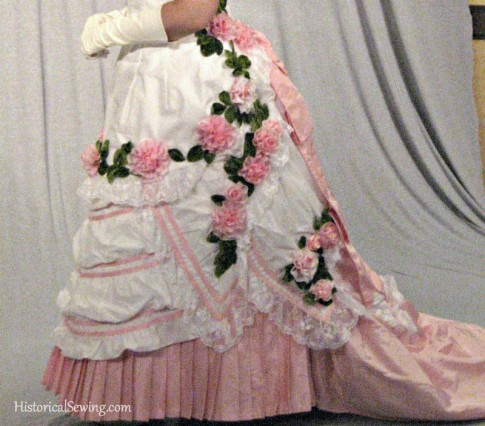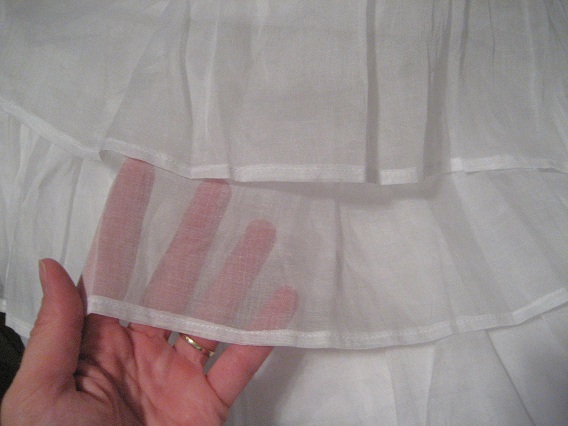
It was a distinct turning point in my historical costuming. I thought I was doing pretty good – my costumes were fairly accurate in style, my undergarments were all present, and my fabric selections did not include polyester or nylon. I soaked up all I could on how to make my Victorian clothing better.
What I didn’t expect was my introduction to a “standard” cotton textile that would ROCK my sewing world.
My friends… meet the Costumer’s Dream Fabric: Organdy.
The Backstory:
My long-time friend, lana/Lily, and I were researching corded petticoats and how starching is so important for an accurate 19th C. look.
Somehow she had recently thought of/found/researched and generally came up on cotton organdy. It was then we ran ahead in our minds and discovered all the glorious uses of this “basic” fabric.
The History:
Organdy is a plain-weave textile generally woven from cotton. It is then treated up to three different ways for either a permanent or semi-permanent finish. This finish is what gives it its stiffness. It’s a similar treatment as starching, and my guess is that today’s organdies are chemical finished.
In my mind, organdy was this unknown fabric that was only used in “old-fashioned” clothing (love that description) and not available anymore. (Have you thought that when hearing the word organdy?)
I still have a Victoria magazine from many, many years ago showing a woman in an organdy dress running through a tall grassy field and a little girl at her side. Her dress was a pure white organdy.

How could you make dresses from organdy? It was somehow embedded in my mind that organdy was stiff. A dress drapes. Organdy doesn’t. Well, that’s before I found out it comes in varying finishes: stiff and soft. (There is a medium finish available but not as quickly found in the marketplace).
The Difference:
Just to clear things up – organDY is made from cotton. OrganZA is traditionally silk but generally in polyester or nylon nowadays. (Avoid this stuff if you don’t want to swear out a storm.)
But you know what makes this the Dream Fabric?
- The weight is very light (HUGE feature)
- The ability to hold other fabrics together (like a base under trim or unusual fabric shapes)
- Holds its own shape (bias stretching is minimal)
- Being made of cotton
- The no need for starch
What You Can Make:
Being naturally stiff, use it for petticoats. 78% of them. Really. Especially the ruffles. You will ask yourself what took you so long to use this fabric.
Corded petticoats are beautiful and light-weight when made from organdy. (You don’t need a heavy fabric – the cords are weighty on their own and the stiff organdy will hold them in just fine.)
The thing about organdy is that it’s already starched so there’s a natural support built in. And it’s super lightweight to begin with (as if I haven’t mentioned it already). It’s a common modern misconception that you have to use a heavy fabric for petticoats. Why do that? Lightweight undergarments rock!

Use as an underlining for bodices and hem facings in skirts, or even fully flatlining a skirt. Collars & cuffs are natural uses. Belts, too, as an interlining.

Try it as a base for manipulated fabrics and applied trims like flowers and ribbons. Both aprons on my 1876 Wedding Cake Dress (above photo) and the 1873 Blackberry Cream Dress utilized organdy under the ruched fashion fabric to hold it in a defined shape.
Fast Sewing Tips:
-It can be slippery under your machine and you’ve got to control it. When you’re sewing a seam, the two edges can slip. Try a long hand baste stitch if you’re fighting with the organdy.
-Pins can slip out easily so pin accordingly.
-It wrinkles. Press as you would any cotton with a hot iron and steam. You may notice as you press the organdy gets soft. Not to worry – it stiffens as it cools.
-Press out all the creases before cutting your pieces. Use a rotary cutter and ruler for more precise cutting.
-Use a smaller needle like 70/10 to avoid large holes.
-Regular cotton/poly or poly thread works just fine.
-Keep to the grainline as you would on any other woven fabric.
Where to Buy Online:
Alas, I haven’t had good luck with finding organdy at the chains like JoAnn’s and Hobby Lobby. The large superstores might carry it for apparel but most of what you’ll find is in the home dec department. It’ll be called “organdy” but be 100% polyester or nylon. AVOID these!
You might also look in the interfacing section. (I know, weird, but it CAN be a great sew-in interfacing, not to be confused with crinoline.)
Pure Silks – A great place online for cotton organdy in both soft and stiff finishes. They are also on eBay as Exclusive Silks. Shipped from India it can take at least two weeks to receive in the US so plan ahead and order 10 yards at a time.
Needle & Thread (as Wooded Hamlet) – I’ve ordered many yards from here and being in the US can get to me quick. You’ll have to call to order & have it shipped. Be sure to ask how stiff their stock is as it varies. I’ve received both finishes from here.
Vogue Fabrics – One choice on the website: stiff, but it’s high quality.
Renaissance Fabrics – Diana has carried organdy in both 45″ and 60″ widths in the past. Inquire about stiffness and yardage in the inventory.
Farmhouse Fabrics – They have various organdies including COLORS. And if you want to go there, a quite expensive imported Swiss organdy – perfect for a little girl’s dress, not so much for a 10 yard-fabric bustle gown.
I encourage you to give organdy a try. You will love it!
Listen to my podcast episode 003 on organdy.
Have you used organdy before? Leave a comment below on what project you used it for.


Thanks, Jennifer for sharing such tips, I always been a fan of Vintage fabrics and love to read a lot about them.
Whaleys sell it (here) and proper silk organza as well (here) (which is fine to work with, unlike the poly crap).
Oh, wonderful! Thanks for the UK option!
Where would you buy the best organdy, to make a petticoat for a 1950’s NEW LOOK dress? I want to know which one to buy that the sizing will not wash out of. Would you use stiff or soft?
Depends on how “pouf-y” of a 1950s look you’re going for and if you’ve already have natural width from your hips. Personally, I’d use soft. Look for the quality organdy at Dharma Trading, Farmhouse Fabrics, Harts Fabric, or Renaissance Fabrics. The stuff at Vogue Fabrics is stiff and is hit or miss on the washing out over time. (like, lots of washes)
Re: the Vogue organdy– if I’m planning on using it for a bustle petticoat, would the stiffness be a good thing? Also, since I may not get the chance to wear it often, how many washes are we talking about before it loses its stiffness?
A lot of washes. I wouldn’t worry too much about it loosing the support and effectiveness when made as a petticoat. I used the stiff organdy from Vogue Fabrics for the ruffles on the bustle petticoat seen in this post (blue stripe). They were a bit too stiff for my liking on that shape. Although, if there were fewer ruffles but deeper width (like 3 or 4 rather than the narrower 6 or 7) is would be better yet still hold a beautiful silhouette. If I make the Truly Victorian bustle petticoat again I’d find the softer organdy. This is simply my own experience. Now, the whole petticoat in stiff organdy would be fine, but I’d recommend another, softer fabric, petticoat over it to smooth it all out…. stiff organdy for the silhouette shape and top petticoat for smoothness under the skirts.
I’m making canopy curtains and accidentally bought the stiff organdy … will washing it soften it?
It kinda depends on the quality of the fabric. Some organdies are cheap and the sizing will wash out after one or two washings. The better stuff will keep the sizing for a long time. I’ve used both – although, it’s not always easy to tell until you start washing and sewing with it. You might wash a scrap to see how it reacts. Or wash the entire piece first. If it goes back stiff then you have good quality and may need to wash several times to get the sizing to break down more.
Thank you! I decided to order a swatch, I’m going to wash that to test it out and then if it doesn’t work I’ll still be able to return the original cut.
I just happened to visit this site because of an old picture from 1946 I came across of me with my Mother in Pocomoke City,Md. I’m wearing a white long dress…needless to say I loved the dress, I was 7 years old….fast forward I was curious about the fabric of the dress and after checking it out am sure it was organdy . SO glad I found the info about organdy fabric. THanks to you.
Connie Rocke
I would agree it was organdy! Lovely fabric for cool summer wear. 🙂
I have been reading your blog for ages, it seems. Can you dye cotton organdy? Planning a costume project and cotton organdy is the ideal fabric to use, however, I can’t seem to find it in the color that I need.
I have never left a comment or asked a question before. Also, congrats on the baby, I know that it has been several months already, they really grow fast. Enjoy these precious moments.
Pren
Thanks Pren!
And yes! You can dye organdy and it should do well being all cotton. I highly recommend dyes from Dharma Trading. Look for their articles on dyeing, too, for how to do it and the best dye to use. Good luck! 🙂
Not historic when I made it – Miss Vogue Vintage Sewing Pattern 7828 – the long version in black and white gingham-check silk taffeta with the sleeves and an added modesty bias neckline ruffle in white organdy. That neckline is cut to below sternum level!
It was crisp and FLOOFY and it swished when I walked.
My mom, for unknown reasons, had YARDS of the stuff, so I also made organdy “hippy” boho blouses and all kinds of things.
Is the only difference between voile and organdy the starch?
No, as the fabrics are woven differently. Simply starching voile will NOT create organdy. Woven & manufactured organdy has the starch specially applied to create the stiffness. Also, organdy thread fibers are thicker cotton with a different twist than those used for voile. Voile is a very soft, drape-able and thin fabric. Organdy, even if the starch washes out (indicating a poor quality fabric), will still have a stiff hand and not soft drape. Organdy is also not as sheer as voile. They are different fabrics.
Would organza work in a similar manner? I’m ordering stuff from Dharma all the time, and it would be a lot more convenient for me to add a few yards of silk organza to my next order than to wait for weeks for stuff to get here from India! I also ordered a sample of organdy from one of the few US sites that has it, but it was much coarser and stiffer than I expected – should a good organdy feel like organza, or is “stiff and coarse” expected?
Yes, it can in the the right instances. I love silk organza for underlining and really like the stuff Dharma sells (great price too!). It IS silk, though, and not cotton which can make a difference for some people and projects. And organdy is stiffer than silk organza (even the “soft finish” organdy). I wouldn’t actually use silk organza for petticoat ruffles as it’s not sturdy enough… unless it’s heavily gathered. I stick to using it as bodice and skirt underlinings, chemisettes, facings for trims, hem facing interlayer, collar support and other projects that need light support.
A shame it burns easy . For myself I plan to sew a gathered skirt with it underneath. I made a waist petit coat with silk organdie awhile back …I love it .
So, if you were doing Scarlett o’Hara’s prayer dress, you’d do organdy ruffles on a cotton base?
For the petticoat, yes. The dress itself can be all of one fabric.
Love organdy for curtains…The curtains always look crisp..wash them and press them right from the washer and back up on rods…no starch mess…just pretty and fresh and crisp
For 18th Century caps, is soft or hard finish organdy better?
Definitely soft.
Thank you!
I just bought some of this fabric for holding the puffed sleeve form of an antique lace I am sewing with. Will it lose its finish if prewashed? The dresses are going to be washed, and I have already prewashed all other fabrics. Thoughts?
Organdy becomes soft with washing, yes. The higher quality stuff will hold its sizing for a good long while which poor quality (aka cheap stuff) will have the sizing wash right out. Organdy will also soften under a steam iron – don’t fear though! As it cools it will stiffen up again. I would definitely pre-wash if you’re going to be washing the final garment. In all my organdy projects I haven’t lost the stiffness, but that’s my own experience.
Hi Jennifer, I’m guessing that cotton organdy can be easily dyed?? It would give the perfect lift to ruffles I need for an underskirt but need it coloured.
It is cotton, so yes, I’m sure it would take dye well. Although, not sure if the dye process would remove some/most/all of the starching that makes organdy stiff. Check with Dharma Trading on dyes and the process for organdy fabric.
It sounds like this might too stiff for a regency era dress, even in the softer version – would you say it has enough drape to use for an early 19th century gown?
I wouldn’t use organdy – even the soft stuff – for Regency dresses. It just doesn’t have enough soft drape due to the starching finish. Better to use a voile or dimity (thicker cotton shirting but still drape-y). You could use soft organdy for fichus and chemisettes in this period though.
Would you use soft or stiff organdy for the petticoat ruffles? I’m making a 1865 petticoat and bought many yards of the stiff version from puresilks a while ago. I think I will make the base skirt where the ruffles will be attached to out of a light cotton fabric.
Thanks
Generally I’d recommend a base of plain cotton like muslin or calico or even soft organdy with the stiff organdy for ruffles to give plenty of lift to the skirt silhouette.
Thank you Jennifer for the comment on the petticoats. I have been making civil war dresses and petticoats for two years now and still feel like a rookie! Your input and wonderful site have been so helpful as I learn my craft..
Growing up in Puerto Rico, organdy was the fabric of choice for all sorts of garments,
From first communion dresses to daytime suits for ladies. We used to go fabric shopping in Old San Juan, (our garment district) where one mostly found imported fabrics. Our organdy was mostly Swiss; dotted, embroidered, plain, mostly white.
Today, my favorite resource for this bounty is a store in NY’s garment district, “European imports”‘. Anyone visiting NY shoul check this area, between 38&40th sts
and 8&6th Aves or thereabouts. I love to get lost in this area and visiting every single store and even pick up cuttings which I then file by store along with their business
card, just in case……
I have also found embroidered organdy at Calico Corner, a great source for extra wide silks and wonderful jackards ideal for Elizabethan clothing.
I love the look of a little girl in Organdy , but I never made a dress for my granddaughter . It is highly flammable. Be careful around open flames.
I made a summer dress out of a light weight bleached muslin. I took it to a fair for a show and was asked if it was organdy…It was very nicely starched, but what would be the difference?
Organdy has a natural stiffness to it and is thin and a bit sheer too. Muslin is more opaque and when made into garments is generally soft and drapes a little. (Industry grade muslin is stiff and rough as it’s a quickly produced textile.)